|
A look onto modern
cosmology |
|
|
 |
|


|
The genesis of the Bing Bang model
When Albert Einstein (1879-1955)
presented in 1916 his theory about
general relativity he had behind him the
certainty of the inexistence of the
ether, given by the experiment of 1887
made by Albert Abraham (1852-1931) and
Edward Morley (1838-1923), which was
that hypothetical rigid medium that we
thought it was a support to the travel
of the light and gravity, and that,
being static, became the absolute
reference of the corps’ movement.
Einstein was facing the void, but he
didn’t consider it as such, because he
thought it as space not meant as pure
extension, but as something able to
occur in gravitational or
electromagnetic field. Einstein traced a
Universe with four-dimensional space,
where the fourth dimension was time,
therefore coming to a non-Euclidean
geometry, meaning that two parallel
lines in the Universe do not remain
perpetually so, but they come to merge
into a point and vice versa open.
According to this the Universe couldn’t
be thought as static, but in contraction
or expansion, and space, in the presence
of a mass of attraction, becomes a
gravitational space, and curvilinear.
The light that has a linear path when it
passes through a gravitational field is
affected by the curvature of space-time
and undergoes a deflection.
It must be immediately said immediately
that the four-dimensional space provides
only a model of facilitation of
calculation in gravity field, because
time has a distinctive character from
space.
A Universe in contraction or expansion
confused Einstein, who introduced a
cosmological constant to his equations
to make his Universe stationary, which
means not in expansion or in contraction.
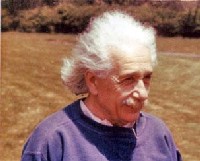
In 1917 the astronomer Vesto Slipher
(1875-1969) of the Lowel Observatory
noted that his comments about some
nebulas showed the existence of light
spectrum with movement toward the red,
which means toward lower frequencies.
Later, in 1918, the astronomer Carl
Wirtz (1876-1939) of Strasbourg
Observatory, noticed the same phenomenon
and found a linear relationship between
the red shift (movement toward
red) of the nebulas and their distance
from the ground measured by a series of
calculations based on yardstick called "standard
candles", ingeniously elaborated
considering the brightness of sidereal
objects. Obviously, these distances are
not absolute distances, which means not
free of margins of errors. The theory of
Vesta Slipher and Carl Wirtz, as well as
Einstein’s Theory of Relativity
convinced the Belgian physicist Georges
Eduard Lemaitre (1894-1966),
independently from the Russian physicist
Alexander Friedman who came to the same
hypothesis, to indicate the existence of
a Universe in expansion. Lemaitre
formulated a law of proportionality
between the distance of celestial
formations and their speed of recession,
that is the speed with which galaxies
seem to move away because of the
Universe in expansion. To this law
landed also, regardless of Lemaitre’s
conclusions , Edwin Powell Hubble
(1889-1953) with his comments, made
public in 1926, and known as Hubble's
Law. Hubble theorized that the Universe
was homogeneous, that showed almost the
same face in all directions, and with
this he didn’t have difficulty thinking
of a Universe in expansion like it was a
balloon.
Following Hubble’s observations, Albert
Einstein stopped introducing the
cosmological constant in the equations.
Lemaitre in 1931 came to propose the
existence of a "primeval atom"
that would explode giving rise to the
Universe. Lemaitre estimated the age of
the Universe as dating back to 10/20
billion years ago. Lemaitre's theory was
called Big Bang (big explosion) by Fred
Hoyle (1915-2001) in 1948-50. Fred Hoyle
was the promoter of a stationary
Universe model, where the missing matter
for the expansion was continually
created. In the ‘40s, on the basis of
the Big Bang model, George Antonovich
Gamow (1904-1968) proposed the existence
of a fossil radiation present in the
Universe, according to the idea that
matter in the first moments of the
expansion was so dense to prevent the
passage of the radiation produced by Big
Bang. Later, after the rarefaction of
the matter, the radiations could filter
flooding the Universe when it was
greatly expanded. Note that the
expansion of the Universe is not
considered in the theory as matter
launched into space, but as matter that
forms the space. Gamow estimated that
the temperature of the radiations was 50
degrees Kelvin; later he rectified this
fact increasing it to 5 degrees Kelvin,
an expectation’s datum that will prove
to be incorrect, for excess almost
double. These considerations determined
the entry into the scientific community
of the Big Bang theory, while showing
all aspects to motivate. The Big Bang,
in particular, speaks about a big
explosion from the matter concentrated
into a single point at high temperature.
A situation of unusual exemption from
all laws of physics, without being
supported, or rather without the
possibility of being any evidence.

No particles
accelerator,
not even the giant LHC (Large Hadron Collider) in Geneva
can reproduce this initial
singularity,
but only the plasma
state of
matter. LHC for the
supporters of the Big Bang theory
can be
described as a time
machine, a race towards the initial
conditions of
the plasma,
but can’t go
further. In fact,
if you look
at the LHC
experiments in
themselves,
they are
nothing more than a survey of
the reality of
matter, of
course, for
what it
is accessible to
man.
The initial
singularity is thus not verifiable by any possible
experience and therefore
does not fall precisely in the
dignity of
theory, but only of
a mathematical
artifice based
on the application of the
theory of
the General Relativity to
the global
dimension of
the Universe. It
invokes a new theory
of the "quantum
gravity", but it
can only move on a pure
mathematical abstraction, not verified by
the Galilean
method of the experiment.
The cosmic background radiation
In 1964 two physicists, Arno Penzias and
Robert Woodrov Wilson, while
implementing the test probes with a new
microwave receiver of the Bell
Thelephone Laboratories, found an
unknown microwave radiation.
Subsequently, the group headed by
Phillip James Peebles of Princeton
University, which had begun to seek such
radiation as being a cosmic background
radiation (CMBR: Cosmic Microwave
Background Radiation), found it. The
radiation appeared isotropic, that is of
equal temperature in all directions, and
this contrasted with the thought that
the Universe is not as homogeneous. In
addition, the temperature levelling
required exchanges between the growth
areas, in fact, if the expansion had
occurred at a faster rate of the
electromagnetic radiation the exchange
would not be possible and then the CMBR
would be very anisostropa. To explain
this, and not see the vanishing of the
Big Bang theory, it resorted to the "inflationary
theory" whose name comes from to
inflate (to swell), alleging that
shortly after the Big Bang there was a
time when "a negative density of the
pressure energy of expansion" acted.
This is why Alan Guth, author of the
inflationary model (1979-1981), invented
a particle hypothesized in action in
those moments: the Inflatlon.
With this, there would have been
primarily an unusual fast expansion
(stretching of space), with cosmic
embryos, induced by the gravitational
energy and the pressure waves and by the
hypothetical dark energy, so
close to allow temperature
homogenization. The experiment
(1998-1999) Boomerang (Balloon
observation of milimetric extagalactis
radiation anisotropy and geophisics; a
ball high in the Antarctic to exploit a
hole in our galaxy) arrived to say that
the Universe currently has an euclidean
geometry (flat universe) on the basis of
a "critical density" of the
Universe. If the universe consisted only
of stars we would have the non-euclidean
space, but to exchange this is not the
case.

The Boomerang balloon, whose shuttle
contained a telescope and a set of tools
for measuring the cosmic background
radiation, detected the radiation
reaching measures one hundred times
lower than those of the satellite COBE
(Cosmic Background Explorer), which,
launched in 1989,recorded an anisotropy
with thermal variations of the order of
a millionth of a Kelvin degree on the
data of 2.726 degrees Kelvin.
In 2003 data from the satellite WMAP (WilkinsonMicrowave
Anisotropy Probe) pointed to differences
in temperature from point to point in
the order of a few millionths of a
degree Kelvin.
The WMAP satellite were examined for a
long time and provided the surprise that
there was a dark area in the direction
of the constellation Eridanus, from
which came the cosmic radiation. It was
an area 900 million light years wide.
The radio telescopes of the VLA (Very
Large Array) in 2007confirmed that from
the dark area did not come any
radiation.
The isotropy (always with the exception
of a certain anisotropy with which the
to inflate is aligned) of the
background radiation necessary to
imagine the beginning of space-time are
deeply shaken. New deeper measurements
will be made by the Planck satellite
placed on a particular orbit a million
and a half km far from the earth, where
the attractions of the sun and the earth
act in the equilibrium position of the
satellite (L2 Lagrangian point).
The position in the opposite direction
of the sun will allow the satellite to
be in the shadow zone created by the
earth and the moon. The new measures may
also reveal a minimum of radiation for
the dark area, but as of now, we must
necessarily think that at the time of
the “to inflate” the universe was
not homogeneous. In fact already
Margaret Geller, along with John Huchra
and Louis Nicolaci Da Costa, in 1989
reported inhomogeneities in the
distribution of galaxies, namely the
presence of clumps of galaxies.
This was confirmed in 1996-98 by an
international team led by Jean Maret
Einasto and Einasto.
Glen Starkman,
professor of physics and astronomy at
the University of Stanford, in his
lecture at the conference in Moncao
(Portugal, summer 2003), suggests that
theCMBR, rather than being seen as the
energy rest of the Big Bang, was
to be considered as coming from stellar
bodies through the mediation of the
clouds of gas and cosmic dust in the
cosmos finally reaching integration with
the system of our galaxy, and hence our
instrumental record of isotropy and
anisotropy.
The satellite
called Planck has provided a set of data
that have been presented last March 21st
2013 by the ESA (European Space Agenda).
The satellite, launched on May 14th
2009 by ESA, has examined the basic
cosmic radiation of the cosmic horizon
visible from the earth (we are able to
see only 5% of the universe) picking up
signals of a millionth of a degree and
providing a detailed map of the cosmic
sky. In order to perform this operation,
the basic radiation has been
appropriately picked out from other
sources of radiation: stars, galaxies,
clusters. As a result, the anisotropy of
the basic radiation has been confirmed.
However, the percentage variation is not
constant, in fact in the right
hemisphere of the sky there is a sharp
asymmetry in percentage, also presenting
a wide “cold” area (according to the
instruments of the Plank satellite
telescope), much more wider than other
10,000 cold areas that are glimpsed in
the cosmic sky. As this was not to be
expected, the standard model is even
more deeply discussed. This lack of
homogeneity of the cosmos does not
really mean that the cosmic laws vary
from area to area, but only that there
is a general cosmic organization that we
cannot understand. According to the
numbers of the standard model, the basic
cosmic radiation was originally found
380,000 years after the Big Bang. We are
told that, in such a condition,
electrons and protons and photons
(electromagnetic radiation) were in a
state of boiling soup with a thousand
times higher temperature than the actual
one in the universe and with a one
billion times greater density. In such a
condition, the photons, even if distinct
from the other particles, were an
integrant part of the soup and prevented
the electrons and the protons from
combine and forming
hydrogen atoms. At this point, we can
assume a tremendous expansion of the
universe (inflation) with such a
temperature decrease that hydrogen atoms
were formed and, therefore, there was
the possibility for the light to be
released. Given that the universe is
still expanding, that light released is
now included in the microwaves range
with temperatures of 2.7 Kelvin above
absolute zero and, according to the
standard model, it is considered as a
fossil remnant
of the Big Bang.
According to an
anonymous
interpretation
(“Avvenire”, March 15th,
2013) in the map provided by the Planck
satellite, we could see the beginning of
nucleosynthesis through fluctuations
(such as sound waves in the matter)
produced alternatively by the gravity
and the repulsion of the electrically
charged particles. But this is not
completely true, given that the
particles of electrons and protons are
complementary (positive charge and
negative charge) and therefore they
attract each other forming hydrogen
atoms; only electrons repel other
electrons and protons repel other
protons. All the
post-soup
densities shown on the map provided by
the Planck satellite, arise from
different realities and not from
oscillations between gravity and
repulsion, just because, according to
the interpretation of the standard model
(this is important not to consider a
static model of the universe), an
expanding universe overcomes the
gravitational attraction that would win
only on a local level, while among the
particles the attraction and the
formation of atoms win. The reality is
much more detailed and complex than many
people would think. As admitted by the
ESA General Director Jean-Jacques
Dordain, the Planck satellite has not
answered all the questions, indeed it
has increased their number.
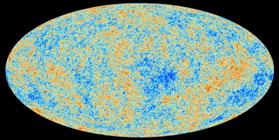
The
red shift
The various substances generate or
absorb certain colors, so for example, a
gas of sodium produces yellow light when
heated, as seen in street lamps. Now,
Hubble saw that the colors in the
spectra of light recorded by looking at
the galaxies were shifted toward the red
from their normal position. Hubble
thought that this shift was due to the
Doppler effect by which light or sound,
issued by a body in motion, undergo a
stretching or compression. Everyone has
noticed that a fast approaching train
emits loud sound (compression waves) and
then after passing a low sound
(stretching of the sound waves). Hubble
conceived the red shift.
But the red shift was deemed to
originate from other phenomena. It a
shift of gravitational type toward the
red, had been conceived, but it must be
said that this implies huge masses and
thus the curvature of space-time
resulting in abandonment of Euclidean
geometry. Then there is the so-called "transverse
Doppler effect" that arises from the
celestial object's rotation on its axis,
but this is accompanied in the area
opposite to the blue shift, that
is the blue shift, so the overall red
shift of a celestial object is not
justified. There is the theory of the "tired
light",that is the theory of the
light that in travelling between
sidereal spaces reduces its energy
moving toward the red. The theory of the
tired light was not much examined, but
it would deserve more attention. Then
there is the thought that the light
passing through very strong magnetic
fields moves toward the red. This effect
has been predicted theoretically by
Albert Einstein and verified
experimentally by Walter Sydney Adams
(1875-1956), director of Mount Wilson
observatory.
The disruption resulted from quasar to
red shift
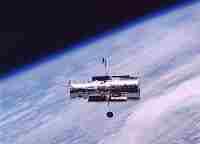
The valid information that leads to the
consideration of the existence of a
phenomenon not yet explained comes from
a star quasar (quasi-stellar radio
source) placed before the nucleus of NGC
7319 galaxy. This galaxy has thick
clouds that hide sidereal objects beyond
its nucleus. The event was photographed
the 3 October 2003, by the orbiting
Hubble telescope and was noticed by
Pasquale Galianni at University of
Lecce, and verified as quasar, with the
telescope Kech I, by Halton Christian
Arp and Margaret Burbidge. Now, quasar
stars have a red shift so high that are
placed to the ends of the Universe. That
quasar star, so bright like all quasars,
according to its red shift, was supposed
to be 90 times deeper.

The red shift, therefore, can’t be
exclusive evidence of the speed by which
astral objects movie away. This fact is
accompanied by other observations of the
astronomer Halton Christian Arp, working
at the Max Planch Institute of Monaco.
Arp is a great expert of astronomical
distances and quasars. He saw that
nearing proximity to almost all the
active galaxies, those with large
emissions along almost the entire
electromagnetic spectrum, such as
infrared, radiowaves, ultraviolet,
x-rays, gamma rays, there is a number of
quasars above average. Arp then
considered the existence of links of
quasar stars with some galaxies that had
a low red shift. Naturally, there
is the Doppler effect, and therefore the
red shift of the speed of
celestial objects remains, but
everything becomes more complex, that is
richer, and the approach to the Universe
can only become much more cautious and
humble.
It will be necessary to explain why
quasars have so high a red shift,
but this may not longer be interpreted
only as a Doppler effect. One
explanation may be that by Albert
Einstein and Walter Sydney Adams, that
is due to the interaction of light with
a strong stellar magnetic field.
It has been also discovered that
galaxies have their own magnetic field (galactic
magnetic field) different from the
addition of the magnetic fields of
individual stars, and these galactic
magnetic fields have their weight in the
formation of galactic red shift.
But there are also striking phenomena
like galaxies colliding with each other
making the whole Big Bang scheme more
complex, that at this point appears only
as a simple sketch of reality.
Plasma cosmology
Strongly alternative to the Big Bang
theory is the so-called plasma cosmology
proposed in the 60s of the XX century by
Hannes Alfven, Nobel Prize for Physics
in 1970.
Expert in the magneto field, Alfven
argued that magnetic fields have had and
still have a key role in the composition
of cosmic structures. It was him who
proved that the Via Lactea had a
magnetic field that was not the simple
sum of stellar ones and suggested that
this galactic magnetic field was due to
the motions of the interstellar plasma.
The Nobel prize also suggested that the
intergalactic plasma has, with its
movements, the ability to generate
strong magnetic fields able to overlap
the action of gravity. Also proposed
that in the cosmos he conjectured,
without origin and without limit
extension, that is infinite, there were
tremendous clashes between matter and
antimatter that gave rise to multitudes
of Big Bang. Although it’s considered
eternal, and then in a static framework,
the cosmos is crossed by time and so in
continuous evolution, that is to say
that it has in itself the continuous
evolution and therefore the time. Hannes
Alfven saw his theory to lose interest
in the 90s’ but, after some difficulties
found in the Big Bang model, a number of
scientists like Eric Lerner have taken
hold of the theory with combactive tone,
and easily recognizable extremes. In
fact, the radiation coming from the
electrical flow of plasma could be only
a synchrotron radiation and thus
strongly polarized, but the cosmic
background radiation recorded by the
instrument is not like this. Then, the
great annihilations of matter and
antimatter conjectured haven’t been
considered like a present and constant
fact. There are in orbit space
laboratories to detect signs of
antimatter, but we can’t conclude that
matter and antimatter are in a constant
dialectic. In fact, the matter had the
upper hand over antimatter in cosmic
processes postulated in the past, today is almost disappeared..
Undoubtedly, Hannes Alfves observations
are precious, but confusing science with
philosophy doesn’t honor him. In fact,
the theory of plasma cosmology says that
the Universe is constantly evolving, and
is forced to say this for the reality of
things, but at the same time shows that
it is in a static framework, which is
exactly of what is eternal. Just to make
an example, if in a basin full of water
the water is agitated by a shock, or by
a gust of wind, or by a vibrator placed
in the water, or by a chemical reaction,
after a while the water returns quiet
because it hasn’t in itself the capacity
to back in motion, but it must receive
it from an external action. So a
Universe without cause prior to its
evolution, because it’s considered
eternal and infinite,not only stops at
some point to have motion in itself, but
even it can have it from the beginning,
because it is eternal and so has no
beginning. Ultimately, the theory of
plasma cosmology, at least as it is made
public, shows the lines of materialist
ideology and transfers to the matter the
dialectic of thesys-antithesys and
synthesis. However matter and antimatter are not in dialectic opposition, but are functional to the whole Universe. The antimatter, in the particle accelerator, is produced in a while and immediately annihilihated by the matter. The antimatter is annihilihated once in contact with the matter. The antimatter has been observed (2013) in the solar explosions-eruptions, by sofhisticated reception equipments of electromagnetic emissions (Heliospheric Observatory - in the orbit at 1,5 million of km from the Earth; it has been launched on the 1995 to study the sun - ESA and NASA project – together with the Japanese Radio-eliograph -
interferometer - Nobeyama, which has been assembled on the ground; it is provided with 84 saucers).The antimatter, in the nuclear solar reaction theory represents a breaking out episode, however the antimatter particles could be launched in the space, and in fact a thin stripe of positrons (electron with positive charge), derived from the sun and other cosmic sources, has been observed on the Van Allen stripes (A 200/1000 km till 40.000 km high particle – plasma taurus around the earth) from the particle detector Pamela (Payload For Antimatter-Matter Exploration and Light-nuclei Astrophysic), placed on a Russian satellite, which has been placed in elliptical orbit between 350 and 600 km in the 2005.
Plasma
cosmology insisted, however, on the
inconsistency of the abstract singular
initial point, it pointed out that there
were physical laws unknown and
disconnected with all the physical
knowledge. Hannes Alfven therefore has
argued that the plasma produced in the
laboratories is the same as that of
interstellar space, the same of that of
nuclear reactions of stars. He said that
there isn’t a change in physical laws
according to which they have changed.
Most likely, just by going against the "abstract
singular initial point" Hannes Alfven
came to the philosophical mistake of the eternal and unlimited Universe.
Cyclic Cosmologies
A simple instance of these cosmologies is that developed by Neil Turok of Cambridge University and Paul Steinhardt of Princeton University. They suggest that the universe is enveloped in a membrane (brana) with which another
brana from another universe collided, bringing about the so-called big bang. But other
branas are ready to cause other collisions and further big bangs. The first point to make is that all these
branas must be contained in a single
super brana. The various branas collide with one another, causing big bangs. This leads to the idea of eternity, in the sense that the finite number of
branas in collision continues for infinite time, and so there would be infinite collisions. But if it is true that two branas have to become one in order to determine a big bang, and so on and so on, then it follows that eternity cannot exist, just as two dice thrown for an infinite time repeat infinitely one or other of the 216 combinations possible. Every
brana which explodes together with another reduces their number, because in exploding they join together. If there is to be an eternal cyclic process there needs to be a force capable of setting the system in motion again and again, by forming new branas. But this external force, which would continue to act for time without end, infinite, cannot be contained in the finite but must be above the finite in order to function in the infinite and to provide infinite combinations; it must be eternity itself: that is to say, God. Here we come back to Friedrich Nietzsche’s myth of the eternal cycle, but it is immediately de-mythified.
Another instance which harks back to the myth of the eternal cycle is
conformal cyclic cosmology (conformal because it would trigger the formation of a universe superimposed on the preceding universe) elaborated by Sir Roger Penrose of Oxford University. This cosmology begins from the formation of black holes which, it is believed, will absorb every type of matter at the death of the universe, making way for a very slow evaporation (Stephen Hawking 1974). It follows that the black holes will vanish and only radiation will remain. At this stage the universe will have been simplified to the point where there is a very low-level
disorder as there was in the beginning, and so the end will join the beginning to bring about a new cycle. This theory contains elements of pure fantasy; in particular the idea of linking the end to the beginning in this way is a real circus trick, and physicists cannot accept that matter loses its mass. But if the universe really did die as foreseen, it could never – without the aid of an external force – begin a new life cycle.
But there are many more instances of pure fantasy along the lines of the esoteric serpent swallowing its own tail. This has nothing whatsoever to do with science.
The nucleosynthesis the problem of
problems
The modern cosmology visions can’t
sustain, if not verbally, that
nucleosynthesis, namely the formation of
the earliest nucleus of the matter able
to attract around them the cosmic matter,
and then initiate to form cosmic objects,
took place for self-development. In fact,
the dynamic expansion of the Universe,
affirmed by Big Bang theory, should have
been aware of the barriers of the
stopping of the matter to thicken it in
the middle of the expansion speed. The
game between the hypothetical dark
matter, which would be the opponent
force to gravity and therefore
responsible for the acceleration of
the surplus - projected from
calculations – of the expansion of the
Universe and the force of gravity,
putting into play the initials acoustic
pressure of the Big Bang, cancels the
assertion of the possibility that the
process of nucleosynthesis has been done
for self-development, in fact it has no
curbing, but rather the reverse. That's
why the Big Bang cosmologists admit that
they have no idea on the formation of
cosmic structures.
The term nucleosynthesis is
elegant, but powerless to express the
formation of large sidereal structures,
because it refers only to the star
formation. The reality however is much
more complex because stars are part of
those magnificent structures which are
the galaxies, and the complexity of
nucleosynthesis increases immensely
if you think that groups of galaxies are
in gravitational concatenation around
their galactic center and rotating
around it, while each rotates around its
gravitational center; and finally, the
complexity rises immensely if you think
that the whole Universe is in admirable
gravitational concatenation. And more
powerless than ever is plasma cosmology
to explain nucleosynthesis,
because the materialist ideology deforms
its scientific path.
The dark matter has been
traced
The first astronomer who hypothesized
the existence of a major quantity of
matter than how it’s visible, was Fritz
Zwicky on the 1933. The astronomer
studied the gravitational behaviour of
two masses of galaxies, those of Virgo
and Swan, reaching the conclusion that
to explain the existence of the
gravitation it occurs the presence of a
big quantity of matter (he told 400
times bigger than how much is visible).
Anyway It was during the ‘70s that was
imposed the doubt according to the major
matter of the universe was bigger than
how much we could see if Newton’s
gravitation laws are applied. For
example, the milky way’s stars without a
big matter which didn’t appear could has
been spreaded around the universe
because of the centrifugal force. They
also noticed that the stars which were
at the centre of the galaxy orbited with
a high speed, and those in the fringe
areas haven’t a lower speed as the
gravitational calculations postulated,
but they were speeder (we all know that
planets which are near the sun rotate
faster then those which are distant). In
this case, too, it should hypothesized
the presence of big masses of
extragalactic matter able to give a
gravitational reason regarding the
outlying stars’ behaviour which where
faster then how it was supposed.
This matter that the calculations
postulated was called “dark matter”, so
not visible. It constituted
approximately the double of those
already observed.
The existence of the “dark matter”
was denied especially by the astronomer
Mordehai Milgrom stating that Newton’
laws weren’t valid on a galactic scale
anymore. However they tried to find the
“dark matter” exploiting the fact that a
ray of light undergoes a gravitational
deflection.
This complex process was called of “gravitational
lenses”. In other words, without any
pretension to explain this process which
availed itself of the comparison of
thousands of pictures, if a ray of light
derived from the galaxy undergoes a
trajectory flexion even in absence of a
visible mass, it means that there was “dark
matter”. The astrophysicists in the
meantime postulated that the “dark
matter” should be of very rarefied
gas of higher temperatures, which
reaches un million of degree Celsius.
This matter was able to emit x rays,
which should have been found by the
instrumentations.
In fact they were captured by the
instrumentations, but the result was
different from that one planned, and
none could found them in the databases.
The only one who could found them was
Miss Amelia Fraser-McKelvie, 22 years
old, student at the Aeorospace
Engineering College of Melbourne
University, during a internship at the
School of Phisics of this university.
The careful observation of these
documentation lead this young student at
this result in only three moths, solving
a puzzle which couldn’t be solved by the
astronomers and
astrophysicists
for two long decades: “the obscure
matter” exists. It has got the predicted
general characteristics, and outside the
galaxies it is present in huge
filaments.
The results obtained by Amelia Fraser -
McKelvi were published on the 4th
and 6th of april 2011 on the
prestigious review “Monthly Notices
of the Royal Astronomical Society”.
This result has cancelled the theory
which supposed that Newton’s laws
weren’t valid in a cosmic scale.
The Astrophysical Journal (March 2012)
reports that in the cluster of the 520
Abell galaxies, 2,4 billion light years
far from the earth, something new,
concerning the blob, has been recorded.
We thought that the blob was strictly
linked with galaxies, so that it
remained connected also during
collisions among them; but the thing is
not so elementary.
The astronomers' explanation is triple.
Either it's about a reality born from
the complex crash of three clusters of
galaxies; or there are the relative
galaxies but they are of such a weak
light intensity that the orbiting
telescope Hubble can't see them; or, in
the crash, the blob joins together with
another blob, like two snowballs,
causing a complex of galactic
gravitational variations.
But what could you say in front of a lot
of data and observations? Personally I
say: God
Personally I think to the initial
creation of a universe in a state of
chaos, where the elements were in shock,
in explosion, in a plasma and huge
movement state. The cosmos in a state of
chaos should not to be considered as
without an implicit order, immanent, of
an order ready to be admirably expressed.
Chaos was ready to receive from God an
omnipotent impulse for the
implementation of nucleosynthesis.

So evolution, but not
self-development, and this is the
substance of the speech that Pope
Ratzinger has addressed the Pontifical
Commission for Science (Roman Observer,
Nov. 1, 2008): "To develop and
evolve, the world first must being, and
then be passed from nothing to being. It
must be created, in other words, from
the first Being that is like this for
essence.
Claiming that the foundation of the
cosmos and of its development is the
provident wisdom of the Creator is not
to say that creation has to do only with
the beginning of world and life history.
It implies, rather, that Creator founds
these developments and supports them,
fixes them and keeps them constantly.
(...) The world, far from being
originated from the chaos, it looks like
an ordered book. It’s a cosmos. Despite
irrational, chaotic and destructive
elements in the long change processes of
the cosmos, matter as such is "legible".
It has an innate "math". The human mind,
therefore, could engage not only in a "cosmography"
studying measurable phenomena, but also
in a "cosmology" discerning the internal
visible logic of the cosmos".
It’s not a problem to think of a
Universe that has known expansions, the
problem is to think that everything
derived from a single source, because
it’s difficult believe to galaxies that
are close (Andromeda galaxy is
approaching Via Lactea and it’s assumed
that in 4 billion years could collide
and merge into a single galaxy) and that
after colliding they become a single
galaxy, as the orbiting telescope Hubble
has revealed to us.
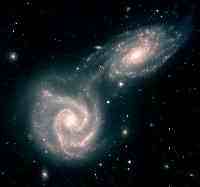
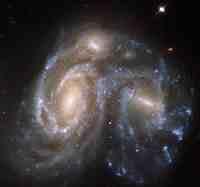
A universe in state of chaos is not
incompatible with the Genesis narration,
where creation of things is seen to
proceed in stages and at the same time
without interruption because, since the
beginning, the matter was created to
form, with the God creation act, plants,
animals and finally man's body with a
spiritual soul.
Genesis narration
Undoubtedly, in the Bible there’s the
notion of an initial Universe as to
reach the present one, as can be seen in
Genesis narration (1,1- 2.4). This
initial Universe can be called with the
classic name chaos.
The text says that in the principle
God created the sky and the earth. The
time begins with the creative act that
produces everything from nothing, that
is not starting from a preexisting
eternal matter.
The text goes on to say that earth was
wrapped by water and that darkness
covered the abyss. The abyss (tehom)
usually indicates the depths of the
ocean, or groundwater, considering that
they are in the depths. But the text
suggests that the waters of the abyss
does not yet exist, there is a single
undifferentiated mass that covers the
earth, so that with the word abyss is
considered the gaseous mass that covers
the waters. The sky, where they will put
stars and sun, is like a dark cloth that
covers the abyss; it miss the light. The
earth is presented like previous to the
creation of light and to the creation of
the sun and stars. The fact is extremely
unusual, and can’t be considered a mere
exception to the common experience of
light emanating from the stars and from
the moon, just to introduce the series
of the days.
The creation of light is such a new
event, the hinge that determines the
transition from the initial Universe to
the current Universe. The source of this
light must be seen, considering the
vision of the ancients (CF. GB 38,19),
in tanks from which it comes out and
returns. Thus we have the day-night,
which is replaced by day-night
determined by the light of the stars and
of the sun.
The text thus constitutes a Universe of
departure. Retreating you can think to a
primordial chaos, where the elements are
in shock, in explosion, so the Universe
of departure takes the configuration of
a step towards the current universe.
Man at the summit of
Man is certainly in relation to the
earth because this is the place he lives
in, because from it he gets food and
tools for his life, but with the earth
he is also in constitutional
relationship because he originated from
it, as affirmed in the Genesis narration
(Gen 2.7) as far as his body is
concerned, being that his soul comes
from God: "Then the Lord God formed
the man with the dust of the ground and
breathed into his nostrils the breath of
life, so the man became a living being".
It’s not exactly accurate to say that
God has placed the man on earth, because
God has made him from the earth. The
Bible says so that firstly comes the
body and then, immediately, the soul
that gives life to the body, and thus is
always: first the formation of the
embryo and then, immediately, the
infusion of the soul immediately created.
We have exactly the opposite in the
reincarnation doctrine: firstly the soul
and then the body that leads the soul
into a journey of atonement for prior
sins.The reincarnation doctrine is
clearly incorrect, even if one considers
the only fact that it breaks the man
unit, reducing the human body to
external accidental reality.
The biblical text (Gn
1,1 s) presents man as the summit of the creative work of God. Man is at
the top of created things, and it’s
perfectly consequent that they are
placed under his feet (Ps 8,7).
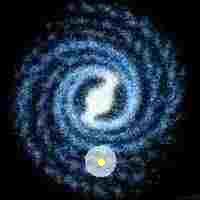
In the last century many people felt
disheartened to learn that the earth is
not at the center of the Via Lactea. For
them not being at the center was a
reason to record a vulnus in
themselves, which they translated into
pessimism about human value, forgetting
that man is at the top of God’s works,
and to be at the top means being at
the center God’s plan, that God gave
us the possibility to know Christ who is
the absolute summit.
The thought that there is vegetal and
animal life on other planets is not
without foundation, because there has
been a long and huge history of forms of
plants and animal life on earth before
man was created. It’s not a deviant
thought because it’s a thought that
gives glory to God, the creator of a
Universe worthy of him.
The draft of God is draft of love, and
the free love of God demands that man's
love for him grows in earthly existence
so that man can reach the apotheosis in
the eternal embrace with him in heaven;
in that sky which is above every
sidereal sky.
So to be at the top of God’s works will
be expressed in the eternal embrace with
God, in enjoying the beauty of the
cosmos, the wonders of so many lives of
plants and animals placed in the planets
suitable for life. So to be at the
summit will coincide with to be truly at
the center of everything, because God
will give to those who corresponded his
love the possession of all.
Then the cosmos will be disrupted and
will emerge in a final form by God, that
eternal and glorious form (Cf. Rm 8,21;
2 Pt 3,10).
 “For
by him were all things created, that are in heaven, and that are in earth,
visible and invisible, whether they be thrones, or dominions, or principalities,
or powers: all things were created by him, and for him: And he is before all
things, and by him all things consist".
(Col 1,16-17)
He is the vertex of
each vertex. He
is the Father's plan.
“For
by him were all things created, that are in heaven, and that are in earth,
visible and invisible, whether they be thrones, or dominions, or principalities,
or powers: all things were created by him, and for him: And he is before all
things, and by him all things consist".
(Col 1,16-17)
He is the vertex of
each vertex. He
is the Father's plan.
Updated on August 27, 2013
|